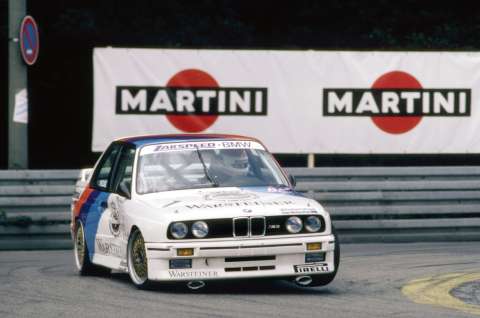2016 marks the 30th anniversary of a motoring icon, one which revolutionised the mid-size sports car segment when its production started in 1986. The very first BMW M3 set a new standard by which other carmakers would be measured – and, five model generations later, are still judged today. Over the three decades that have followed, BMW M has gently refined its trailblazing and highly successful creation from one generation to the next, while always taking great care to preserve the original character of the M3.
Use in touring car racing was the overriding development objective for the first-generation BMW M3.
The BMW M3 was not an attempt to produce a sporting flagship for a volume produced model range; instead it originated from the idea of developing a racing car for motor sport that would also be available in a road-going version. The selected category of racing was Group A production touring cars – as seen in the German Touring Car Championship (DTM) that had succeeded the German Racing Championship (DRM). The Group A regulations stated that for a racing car to be homologated, at least 5,000 road-legal units had to be sold within 12 months.
Having the chance to develop the production and race versions of the car alongside one another presented the development team with a tremendous opportunity, which they duly capitalised on. The axle kinematics, suspension and damping were all perfectly tailored to the future demands of motor racing, as was the braking system, which combined the standard ABS with inner-vented brake discs at the front and an engine-driven high-pressure pump. Details such as the transmission’s shift pattern with first gear at the bottom left also gave a clear indication of the vehicle’s singular focus on racing.
On top of this came extensive weight-saving measures. While the body with broad wheel arches was manufactured from sheet metal in the traditional manner, the front and rear bumpers along with the side skirts, boot lid and spoiler were made of plastic, reflecting the engineers’ commitment to intelligent lightweight construction. The BMW Motorsport experts tweaked the car’s aerodynamics too, with the C-pillar of the BMW M3 following a slightly shallower angle than the standard body and having a broader base. This allowed the airflow to be directed towards the distinctive rear spoiler more effectively.
Extensive use of high tech in the powertrain, too.
The experts at the Motorsport department used the two-litre four-cylinder engine fitted in series-production models as the basis for the M3’s unit, as the low weight of its construction and its high-revving capabilities meant it had exactly the right ingredients for a racing engine. To transform the well-mannered everyday engine into an athletic performer with sports car credentials, however, they had to subject it to some intensive power therapy.
First, they increased its displacement to 2.3 litres and converted it to a four-valve arrangement. For this purpose, the team employed a suitably modified cylinder head taken from the six-cylinder engine featured in the BMW M1, whose combustion chambers were – conveniently enough – spaced exactly the same distance apart as the four-cylinder unit’s. The crank drive on the BMW M3 was designed to be so rigid that it could handle 10,000 revolutions per minute and more. The standard production car’s rated engine speed of 6,750 rpm therefore left plenty of margin for further evolutions of the motor sport off-shoot.







